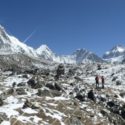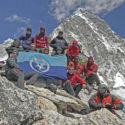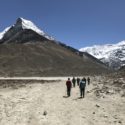On 19 April 2017 a team of 21 regular and reserve soldiers left London for Nepal to take part in Exercise Diamond Peak; a month long high altitude trekking and climbing expedition to the Himalayas. The expedition was planned as part of the Army Air Corps (AAC) Diamond Jubilee Celebrations to mark sixty years since the Corps was formed. All regiments of the AAC were represented, including two reservists. The expedition was further supported by three more reservists; a Doctor and two Alpine Mountain Leaders (AML); all essential staff required to enable the team to function at high altitude.
The ultimate aim of the expedition was to scale to the summit of Island Peak (ImjaTse) (6189m) with a group of novice climbers. On route to Island Peak, a series of exciting acclimatisation treks were planned, which in themselves were worthy of an expedition.
After a few days in Kathmandu to sort out kit and take in some of the sights, the team took an internal flight to the airstrip at Lukla; sometimes known as the most dangerous airport in the world, it was an interesting landing onto the sloping runway nestled into the side of a mountain. From there, the only transport choice was to walk. Some of our heavy kit was transported by animals locally known as Jodpe which are a crossbreed between a Yak and Cow. Not as hardy as the Yak, but work more easily at lower altitudes where the temperatures are higher.
Notable successes on the route included treks to Ama Dablam Base Camp (4600m), Everest Base Camp (5364m) and the summit of Kala Pathar (5545m). The successively higher treks were necessary to allow the body to acclimatise safely. At the top of the peaks, it was required to exist on as little as 50% of the oxygen available at sea level. Some instances of Acute Mountain Sickness (AMS) were detected by our doctor and swiftly dealt with by sending those affected to lower altitudes for a day or two.
On reaching Chkkung (4730m), the AMLs made good use of up to date information available from climbers and guides returning from Island Peak. It was established that recent changes in the condition of the mountain had made the final push to the top untenable with a novice group such as ours. A glacier had pulled away from the mountain leaving a crevasse or bergschrund which had to be crossed by ladder. A vertical rock face the other side of the bergschrund also required the use of a fixed ladder; both outside of the scope of this expedition. The difficult but correct decision was taken that the trek to Island Peak Base Camp was as close as we would be getting to the summit of Island Peak. As Sgt Gary Naylor said, “The mountain always has the final say, and no expedition is complete until all team members are safely back home”. Wise words in an unforgiving environment.
Major Chris Andrews, the expedition leader summed up the challenges and experiences of the trip; “Everybody takes something away from a challenging expedition like this, whether it be the effect of altitude on the body and mind; always a good leveller, or the respect that we all felt for the local people who cope so well with the environment when we were struggling with the simplest tasks”.
There was a feeling that the team left the mountains with an element of unfinished business; Island Peak was not climbed. One of the original objectives was to introduce soldiers to the expedition mind-set and to ignite a thirst for more, thus bringing on the expedition leaders of the future. The AAC has certainly not finished with Island Peak and with the support of charities such as the Ulysses Trust, a return visit is almost guaranteed.




